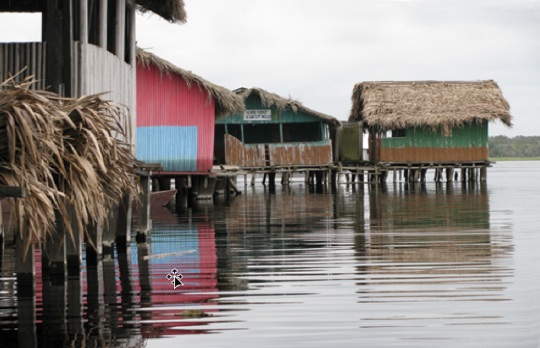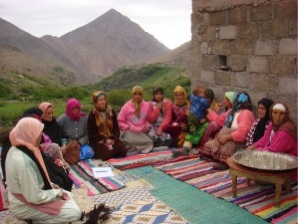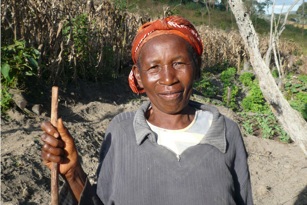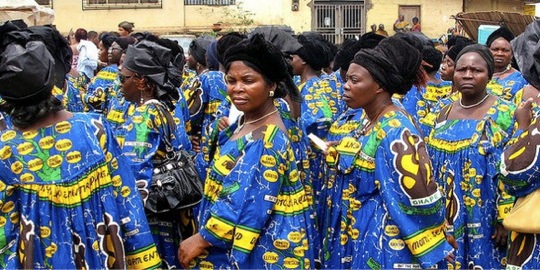2012 April blog
Reggie Annan

Kumasi, Ghana. This month, I write about International Women's Day, celebrated all over the world last month on 8 March. Is it necessary? How important is this celebration to the promotion and protection of women's rights and how does this linked to a world without hunger, malnutrition and disease? In this column I am thinking primarily of women in Africa. I start with a picture of Nzulezu, a village in the western region of my country, Ghana, which is all on a river. It is a UNESCO world heritage site.
International Women's Day
The story of women's day
On the evening of 8 March – last month – my wife and I were watching news on Ghana television and having a chat. Our attention was on the conversation until something caught our attention. It was a group of mainly black women, some young, and some middle-aged, dancing and looking jubilant. It was International Women's Day celebration 2012. For about 20-30 minutes the news of this celebration around the world and in Ghana continued.
I was fascinated and happy by the time and coverage the celebration received on national television for Ghana because it showed the significance of the events to the country. I thought to myself this is a good sign, we have come a long way in promoting women in our society. So then the question is how far has the world come in promoting women and how far have we got to go? But you may want to know if it is at all necessary to set aside a day for such a purpose. The answer is yes, and perhaps especially in Africa, and I will tell you why; but for now some history.

In 1910 Clara Zetkin (1857-1933), a leader of the German Social Democratic and then Communist party, and in the year of her death the leader of the German parliament (the Reichstag) by seniority, proposed an International Women's Day, at the second International Conference of Working Women (1). Here she is above, commemorated on postage stamp and banknote issued by the German Democratic Republic (East Germany). More than 100 women from 17 countries participated, and unanimously approved the suggestion. The very first IWD was launched the following year on 19 March in Austria, Denmark, Germany and Switzerland. More than one million women and men attended rallies supporting women's rights. In 1913, IWD was moved to 8 March, which has remained the global date ever since.
The United Nations first recognised IWD in 1975, as a celebration of the economic, political and social achievements of women. The UN General Assembly cited two reasons for adopting its IWD resolution:
- To recognise the fact that securing peace and social progress and the full enjoyment of human rights and fundamental freedoms requires the active participation, equality and development of women.
- To acknowledge the contribution of women to the strengthening of international peace and security.
Each year the United Nations declares an overall International Women's Day theme. Thousands of events occur throughout the month of March. Different themes have been used since 1975 and I have listed them from 1996 (2).
1996 Celebrating the past, planning for the future
1997 Women at the peace table
1998 Women and human rights
1999 World free of violence against women
2000 Women uniting for peace
2001 Women and peace: women managing conflicts
2002 Afghan women today: realities and opportunities
2003 Gender equality and the Millennium Development Goals
2004 Women and HIV/AIDS
2005 Gender equality beyond 2005: building a more secure future
2006 Women in decision-making
2007 Ending impunity for violence against women and girls
2008 Investing in women and girls
2009 Women and men united to end violence against women and girls
2010 Equal rights, equal opportunities: progress for all
2011 Equal access to education, training and science and technology
2012 Empower rural women – end hunger and poverty
The themes are about involving women in conflict resolution and bringing peace, protecting them against all forms of violence, giving them not just opportunities but equal opportunities and rights to health, education and leadership, addressing specific health issues of women, and this year empowering them to achieve the millennium development goals. These are all of special importance in Africa. The overall aim is to ensure that women have an equal say, and equal opportunities to realise their potential. Although the UN chooses an overall theme each year, organisations, governments, charities and women's groups around the world develop their own themes that are more relevant to their local contexts.
IWD 2012
Empowering rural women

This year's celebration emphasised the responsibilities and roles rural women can and will play, if empowered, in ending undernutrition and poverty, two key targets for the achievement of the Millennium Development Goals (MDG). The first of the seven Millennium Development Goals is to reduce poverty by half. MDG4 seeks to reduce infant and child mortality by two-thirds. Hunger and malnutrition are major causes of death in children and adults. Poverty is the main reason why there is food and nutrition insecurity in many parts of Africa. Poverty contributes to disease incidence and is associated with maternal health, HIV/AIDS prevalence, environmental sanitation and low educational status. By addressing poverty and hunger, it is possible to address almost if not all the MDGs.
Here are the words of the UN Secretary-General Ban Ki-moon on the eve of the IWD celebrations (3). 'Rural women and girls make up a quarter of the global population, yet they routinely figure at the bottom of every economic, social and political indicator, from income, education and health to participation in decision-making. They perform most of the unpaid work in rural areas and are a major part of the agricultural labour force, making up almost half a billion smallholder farmers and landless workers. Countries where women lack land ownership rights or access to credit have significantly more malnourished children. By empowering rural women we could end the hidden development tragedy of stunting, which affects almost 200 million children worldwide'.
Michelle Bachelet, former president of Chile, now executive director of the UN Entity for Gender Equality and the Empowerment of Women, states (3): 'No enduring solution to the major global challenges – from climate change to political and economic instability – can be solved without the full empowerment and participation of women across the world'. Providing women farmers with equal access to resources would result in 100 to 150 million fewer hungry people, while ensuring that they have income, land rights and credit; and this would mean fewer malnourished children. She also states: 'Studies show that higher levels of gender equality correlate positively with higher levels of per capita gross national product. Opening economic opportunities to women would significantly raise economic growth and reduce poverty. Women's full and equal participation in the political and economic arena is fundamental to democracy and justice, which people are demanding. Equal rights and opportunity underpin healthy economies and societies'.
I have said this before, and I will say it again. The MDGs are above all continents about Africa. This is because ours is the continent with most of the worlds' poor, starving and undernourished. Ours is the continent with most maternal morbidity and mortality and people living with HIV/AIDS. Ours is the continent where the status of women, especially rural women, is lowest and poorest. With this in mind, I have found out how International Women's Day was celebrated in Africa. and what is being done to empower women, especially rural women.
IWD in Ghana
Giving girls confidence

In my own country of Ghana, it is increasingly recognised that the single most effective way of reducing poverty is to educate the girl child. Girls in rural areas such as that pictured above are encouraged to go to school even if it means quite a long bicycle ride to the nearest school.
In the upper east region, one of the ten regions of Ghana, Lucy Awuni, the deputy minister, called on women to use the opportunities government has given to empower them and their families, at a programme organised by the Department of Women (4). She said the theme for this year's International Women's Day was relevant to the Ghanaian situation. Immense efforts have been made towards poverty alleviation, particularly in the rural areas, through implementation of relevant government policies and programmes. She said that Ghana has instituted programmes that aim at creating wealth, accelerating poverty reduction, and protecting the vulnerable and the excluded. The government is also determined to counter male dominance in politics, by encouraging women to take up political posts in the country.
In Accra, a workshop was organised where girls were involved and shared discussion with women about empowerment. The aim was to prepare girls so that they will be confident women.
IWD in Morocco
Rural cooperatives

Michelle Bachelet visited Rabat as part of the IWD, and commended Morocco for its achievements in consolidating women's rights following a meeting with a national minister, Youssef Amrani. She said that Morocco showed firm commitment to fostering the rule of law and the modern state as evidenced by adopting a family code along with other political reforms. Youssef Amrani said that the meeting was an opportunity to highlight Morocco's efforts to empower women. The new national constitution enshrines gender equality (5).
Others on this day stressed that rural Moroccan remains a male-dominated society Nevertheless, women are more active than their urban counterparts, and attend to unpaid work that includes household and field chores, child rearing, and looking after livestock. Rural Moroccan women have been empowered through cooperatives. Since 2005, the National Initiative for Human Development has helped rural women such as those pictured above, and has succeeded in making their own mark in economic development. Women's cooperatives have played a leading role in improving the conditions of rural life by helping rural women earn modest incomes (6).
IWD in Malawi
Fundamental empowerment

In Malawi several projects have been implemented to improve the lives of women. These include fostering women's skills and understanding in health education, agroforestry techniques and skills development. The projects target female-headed households, orphan-hosting households and HIV/AIDS sufferers as a priority (7). Agricultural training programmes have assisted women such as shown above, and other vulnerable groups, by enabling them to produce higher crop yields, thus improving their health, income, and ability to care for their families. Health education and mobile HIV testing projects have given women greater understanding and control of their health, as well as tackling the stigma often associated with the disease. School bursaries have helped to redress the gender balance in education.
IWD in Cameroon
Fabric power

IWD is colourfully celebrated in Cameroon each year with a march past and other events including making a special fabric for the occasion, sown into different styled dresses, as pictured above. Some are concerned that the essence of the celebration is being lost. An eye witness had this to say.
'Every single Women's Day in Cameroon comes with a Women's Day fabric, known in local parlance as Women's Day wrapper. Laking, the famous fabric dealer in Cameroon, is working overtime just to meet with women's demand of the fabric. The general cry of this year is that the demand of the fabric is more than the supply. Women are frustrated with the situation. A few traders who have the fabric have increased the price by at least 20 per cent. Women have focused more on acquiring the fabric than achieving equality and empowerment. Women's day has become more like a celebration of the fabric rather than an awareness campaign. If you happen to stand around women who seem to be talking about Women's Day, then listen carefully, they are obviously talking about the price of the fabric, the design they are going to stitch their fabric, the quality of the fabric, future productions and so on' (8)
IWD in Africa
A long way to go
Women in Africa now have more influence in business, government, politics, public administration and other professions. More girls are going to school and are growing up healthier and better equipped to realise their potential. However, we have a long way to go before women and girls can be said to enjoy fundamental rights, freedom and dignity that will enhance their well-being. Four aims at least need to be achieved in Africa:
- All women should have equal pay for equal work.
- All girls especially in rural areas should be educated at least at primary level, with targets set for full secondary education.
- Women should be involved in decision making at all levels of government.
- Rural women should be paid for all the types of work that they do, at the very least for work done outside the home.
References
- See Wikipedia. Clara Zetkin http://en.wikipedia.org/wiki/Clara_Zetkin. As of 19 March 2012
- International Women's Day. Connecting girls inspiring futures obtainable at http://www.internationalwomensday.com/theme.asp
- Empowering rural women key to boosting welfare of societies, UN officials stress. Morocco World News. Obtainable at http://moroccoworldnews. com/2012/03/empowering-rural-women-key-to-boosting-welfare-of-societies-un-officials-stress/30403
- Ghana Vibe. UER celebrates International Women's Day. Obtainable at http://vibeghana.com/2012/03/10/uer-celebrates-international-womens-day/
- 5 UN Women Executive Director commends Morocco for consolidating women's rights. Morocco World News. Obtainable at http://moroccoworldnews.com/2012/03/un-women-executive-director- commends-morocco-for-consolidating-womens-rights-2/30534
- Saoud Izem S. Empowerment of rural women in Morocco. Morocco World News. March 2012. obtainable at http://moroccoworldnews.com/2012/03/8march-empowerment-of-rural-women-in-morocco/30448.
- International Women's Day. Temwa. Obtainable at http://www.temwa.org/news.html
- Nakiti . Women's Day Fabric in Cameroon: What IWD 2012 holds for us. World Pulse, March 2012. Obtainable at http://worldpulse.com/node/50188.
Acknowledgement and request
You are invited please to respond, comment, disagree, as you wish. Please use the response facility below. You are free to make use of the material in this column, provided you acknowledge the Association, and me please, and cite the Association’s website.
Please cite as: Annan R [Column]. The story of Women's Day. Website of the World Public Health Nutrition Association, April 2012. Obtainable at www.wphna.org.
The opinions expressed in all contributions to the website of the World Public Health Nutrition Association (the Association) including its journal World Nutrition, are those of their authors. They should not be taken to be the view or policy of the Association, or of any of its affiliated or associated bodies, unless this is explicitly stated.
This column is reviewed by Geoffrey Cannon.






